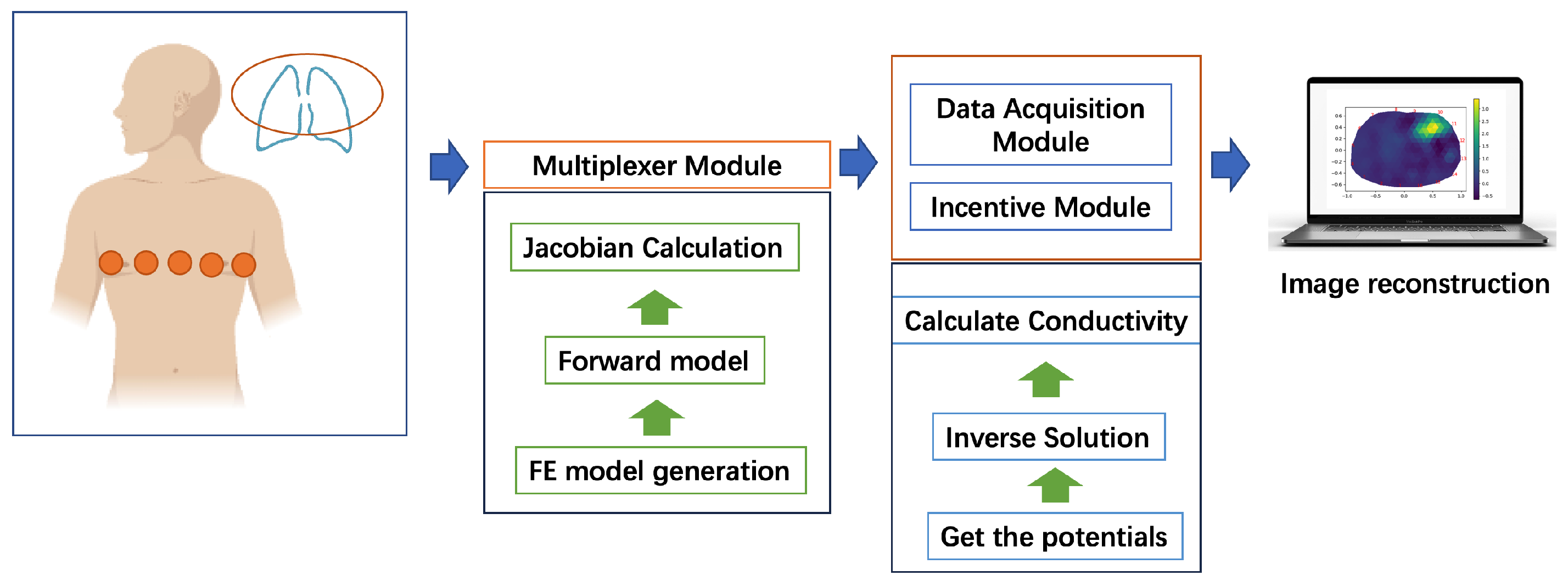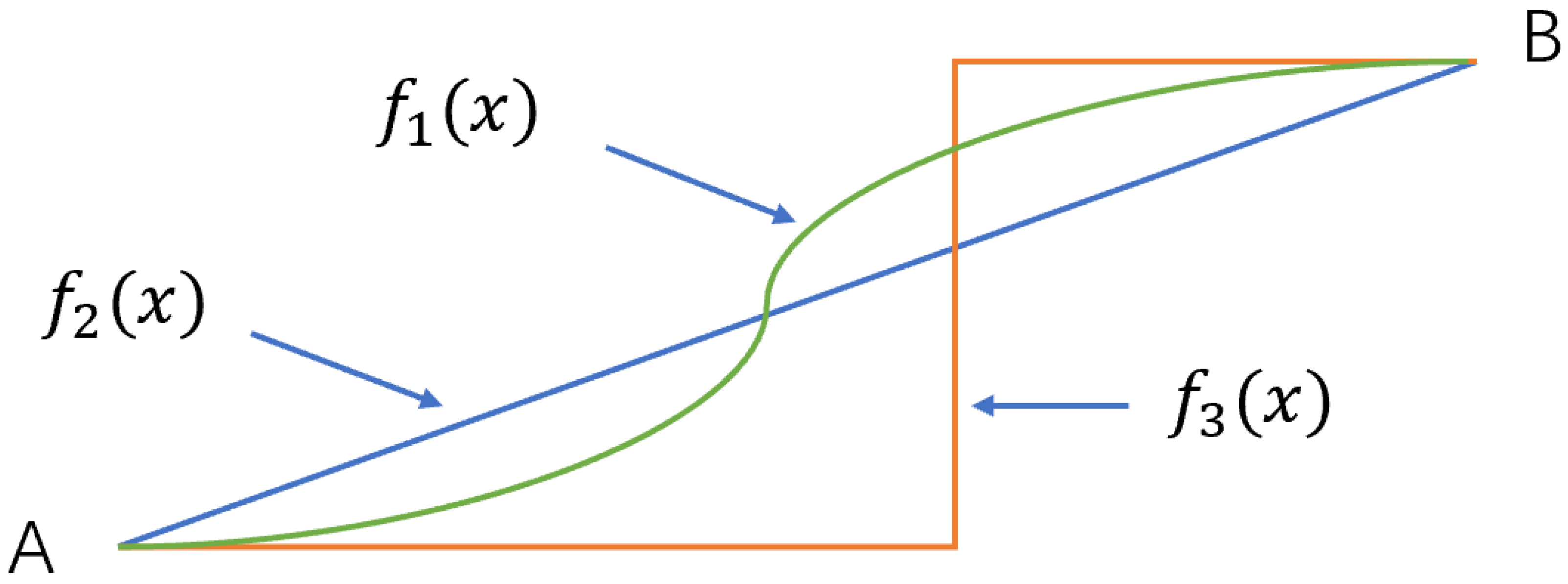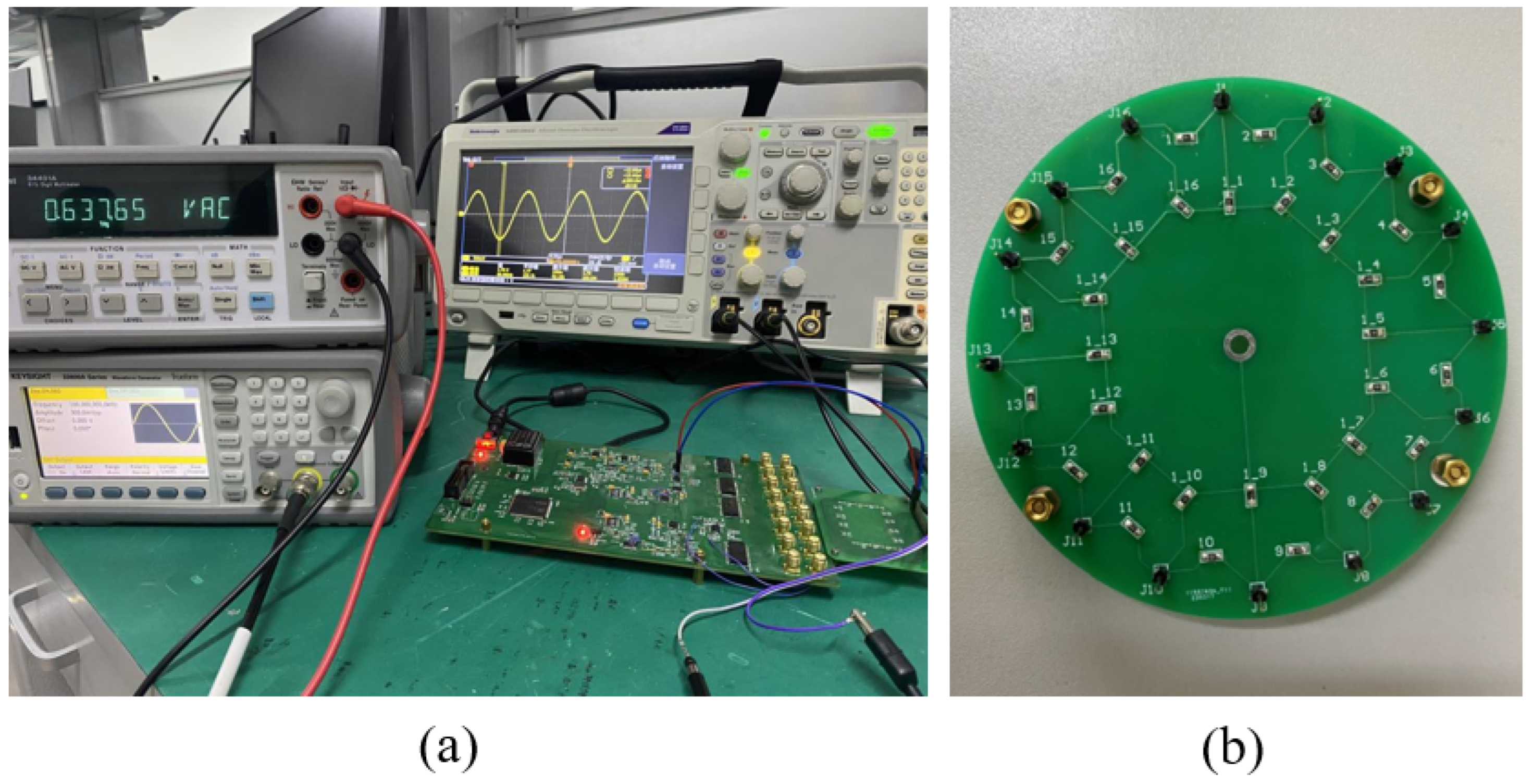A Second-Order Generalized Total Variation with Improved Alternating Direction Method of Multipliers Algorithm for Electrical Impedance Tomography Reconstruction
Abstract
1. Introduction
1.1. Our Contribution
- We propose a SOGTV regularization algorithm that can more effectively smooth the noise of EIT images while preserving the edge information of key lung structures. Compared with traditional algorithms, the new algorithm preserves edges more precisely when processing EIT data.
- To address the dual problem in the SOGTV regularization model, we propose an improved ADMM that combines Nesterov gradient descent and variable orientation multiplier (ADMM) methods. Our algorithm solves the model by leveraging the equivalent form of SOGTV.
- To evaluate the effectiveness of the algorithm, we initially utilized simulation data based on EIDORS for conducting the simulation experiments. Subsequently, we employed the physical model of the circular water tank that we developed to validate our findings. The imaging results clearly demonstrated that our algorithm is capable of accurately identifying the perturbation position of the acrylic cylinder.
1.2. Related Work
- Traditional TV regularization:Strengths: Good at preserving edges by promoting sparsity in the first derivative of the image. It is well-studied and understood within the community [21].Weaknesses: Can lead to the ‘staircasing’ effect, where smooth transitions are turned into piecewise constant regions. This effect is undesirable in EIT, where smooth conductivity changes are common [22].
- Higher-order TV regularization (HOTV):Strengths: Addresses some limitations of traditional TV, such as staircasing, by considering higher-order derivatives [23].Weaknesses: May not be as effective at preserving fine details as second-order TV, and the selection of regularization parameters becomes more complex [19].Strengths:Specifically designed to overcome staircasing by incorporating second-order derivatives.Balances the preservation of edges and smooth regions better than traditional TV, particularly in EIT, where conductivity distributions can have complex structures [24].Can be more robust to noise and data inconsistencies due to its higher-order nature.
1.3. Paper Organization
2. Methodology
2.1. The Mathematical Model of EIT
2.2. TV Regularization
3. Our Proposed Method
| Algorithm 1 The algorithm of the second-order generalized regularization model for EIT. |
| Input: |
|
| Output: |
|
4. Experiment
4.1. Metrics
4.1.1. Peak Signal-to-Noise Ratio
4.1.2. Structural Similarity Index Measure
4.1.3. Learned Perceptual Image Patch Similarity
4.2. Results
5. Conclusions
Author Contributions
Funding
Institutional Review Board Statement
Informed Consent Statement
Data Availability Statement
Conflicts of Interest
References
- Adler, A.; Boyle, A. Electrical Impedance Tomography: Tissue Properties to Image Measures. IEEE Trans. Biomed. Eng. 2017, 64, 2494–2504. [Google Scholar]
- Borsic, A.; Halter, R.; Wan, Y.; Hartov, A.; Paulsen, K.D. Electrical impedance tomography reconstruction for three-dimensional imaging of the prostate. Physiol. Meas. 2010, 31, S1–S16. [Google Scholar] [CrossRef]
- Shin, K.; Mueller, J.L. Calderón’s Method with a Spatial Prior for 2-D EIT Imaging of Ventilation and Perfusion. Sensors 2021, 21, 5635. [Google Scholar] [CrossRef] [PubMed]
- Zhang, J.; Patterson, R. Non-invasive determination of absolute lung resistivity in adults using electrical impedance tomography. Physiol. Meas. 2010, 31, S45. [Google Scholar] [CrossRef] [PubMed]
- Colibazzi, F.; Lazzaro, D.; Morigi, S.; Samoré, A. Learning nonlinear electrical impedance tomography. J. Sci. Comput. 2022, 90, 58. [Google Scholar] [CrossRef]
- Zhang, K.; Li, M.; Yang, F.; Xu, S.; Abubakar, A. Electrical impedance tomography with multiplicative regularization. Inverse Probl. Imaging 2019, 13, 1139–1159. [Google Scholar] [CrossRef]
- Adam, E.E.B.; Babikir, E. Survey on medical imaging of electrical impedance tomography (EIT) by variable current pattern methods. J. ISMAC 2021, 3, 82–95. [Google Scholar] [CrossRef]
- Lu, L.; Liu, L.; Hu, C. Analysis of the electrical impedance tomography algorithm based on finite element method and Tikhonov regularization. In Proceedings of the 2014 International Conference on Wavelet Analysis and Pattern Recognition, Lanzhou, China, 13–16 July 2014; pp. 36–42. [Google Scholar] [CrossRef]
- Liu, D.; Smyl, D.; Du, J. A Parametric Level Set-Based Approach to Difference Imaging in Electrical Impedance Tomography. IEEE Trans. Med. Imaging 2019, 38, 145–155. [Google Scholar] [CrossRef]
- Jauhiainen, J.; Kuusela, P.; Seppanen, A.; Valkonen, T. Relaxed Gauss–Newton methods with applications to electrical impedance tomography. SIAM J. Imaging Sci. 2020, 13, 1415–1445. [Google Scholar] [CrossRef]
- Song, X.; Xu, Y.; Dong, F. A spatially adaptive total variation regularization method for electrical resistance tomography. Meas. Sci. Technol. 2015, 26, 125401. [Google Scholar] [CrossRef]
- Varanasi, S.K.; Manchikatla, C.; Polisetty, V.G.; Jampana, P. Sparse optimization for image reconstruction in Electrical Impedance Tomography. IFAC-PapersOnLine 2019, 52, 34–39. [Google Scholar] [CrossRef]
- E, W.; Yu, B. The Deep Ritz method: A deep learning-based numerical algorithm for solving variational problems. Commun. Math. Stat. 2017, 6, 1–12. [Google Scholar] [CrossRef]
- Wei, Z.; Liu, D.; Chen, X. Dominant-Current Deep Learning Scheme for Electrical Impedance Tomography. IEEE Trans. Biomed. Eng. 2019, 66, 2546–2555. [Google Scholar] [CrossRef]
- Khan, T.A.; Ling, S. Review on Electrical Impedance Tomography: Artificial Intelligence Methods and its Applications. Algorithms 2019, 12, 88. [Google Scholar] [CrossRef]
- Capps, M.; Mueller, J.L. Reconstruction of Organ Boundaries With Deep Learning in the D-Bar Method for Electrical Impedance Tomography. IEEE Trans. Biomed. Eng. 2021, 68, 826–833. [Google Scholar] [CrossRef]
- Sun, W.; Zhu, Z.; Zhao, R. A modified LS conjugate gradient algorithm for solving Symm integral equation. J. Guilin Univ. Electron. Technol. 2018, 38, 158–161. [Google Scholar] [CrossRef]
- Theertham, G.T.; Varanasi, S.K.; Jampana, P. Sparsity Constrained Reconstruction for Electrical Impedance Tomography. IFAC-PapersOnLine 2020, 53, 355–360. [Google Scholar] [CrossRef]
- Parisotto, S.; Lellmann, J.; Masnou, S.; Schönlieb, C.B. Higher-Order Total Directional Variation: Imaging Applications. SIAM J. Imaging Sci. 2020, 13, 2063–2104. [Google Scholar] [CrossRef]
- Gong, B.; Schullcke, B.; Krueger-Ziolek, S.; Zhang, F.; Mueller-Lisse, U.; Moeller, K. Higher order total variation regularization for EIT reconstruction. Med. Biol. Eng. Comput. 2018, 56, 1367–1378. [Google Scholar] [CrossRef]
- Pan, Q.X.; Li, Y.; Wang, N.; Zhao, P.F.; Huang, L.; Wang, Z. Variational Mode Decomposition-based Synchronous Multi-Frequency Electrical Impedance Tomography. Inf. Technol. Control. 2022, 51, 446–466. [Google Scholar] [CrossRef]
- Song, X.; Xu, Y.; Dong, F. A hybrid regularization method combining Tikhonov with total variation for electrical resistance tomography. Flow Meas. Instrum. 2015, 46, 268–275. [Google Scholar] [CrossRef]
- Zhou, Z.; dos Santos, G.S.; Dowrick, T.; Avery, J.; Sun, Z.; Xu, H.; Holder, D.S. Comparison of total variation algorithms for electrical impedance tomography. Physiol. Meas. 2015, 36, 1193. [Google Scholar] [CrossRef] [PubMed]
- Li, X.; Wang, W. A high order discontinuous Galerkin method for the recovery of the conductivity in Electrical Impedance Tomography. J. Comput. Appl. Math. 2023, 434, 115344. [Google Scholar] [CrossRef]
- Bikowski, J.; Mueller, J.L. 2D EIT reconstructions using Calderon’s method. Inverse Probl. Imaging 2008, 2, 43–61. [Google Scholar] [CrossRef]
- Borsic, A.; Graham, B.M.; Adler, A.; Lionheart, W.R.B. In Vivo Impedance Imaging with Total Variation Regularization. IEEE Trans. Med. Imaging 2010, 29, 44–54. [Google Scholar] [CrossRef]
- Rudin, L.I.; Osher, S.; Fatemi, E. Nonlinear Total Variation Based Noise Removal Algorithms. Physica D 1992, 60, 259–268. [Google Scholar] [CrossRef]
- Gilboa, G. Nonlinear Eigenproblems in Image Processing and Computer Vision, 1st ed.; Springer Publishing Company, Incorporated: Berlin/Heidelberg, Germany, 2018. [Google Scholar]
- Fan, W. Electrical impedance tomography for human lung reconstruction based on TV regularization algorithm. In Proceedings of the 2012 Third International Conference on Intelligent Control and Information Processing, Dalian, China, 15–17 July 2012; pp. 660–663. [Google Scholar] [CrossRef]
- Burger, M.; Osher, S. Convergence rates of convex variational regularization. Inverse Probl. 2004, 20, 1411. [Google Scholar] [CrossRef]
- Bredies, K.; Kunisch, K.; Pock, T. Total Generalized Variation. SIAM J. Imaging Sci. 2010, 3, 492–526. [Google Scholar] [CrossRef]
- Jung, Y.M.; Yun, S. Impedance Imaging With First-Order TV Regularization. IEEE Trans. Med. Imaging 2015, 34, 193–202. [Google Scholar] [CrossRef]
- Niu, S.; Gao, Y.; Bian, Z.; Huang, J.; Chen, W.; Yu, G.; Liang, Z.; Ma, J. Sparse-view X-ray CT reconstruction via total generalized variation regularization. Phys. Med. Biol. 2014, 59, 2997. [Google Scholar] [CrossRef] [PubMed]
- Knoll, F.; Bredies, K.; Pock, T.; Stollberger, R. Second order total generalized variation (TGV) for MRI. Magn. Reson. Med. 2011, 65, 480–491. [Google Scholar] [CrossRef] [PubMed]
- Brinkmann, E.M.; Burger, M.; Grah, J.S. Unified models for second-order tv-type regularization in imaging: A new perspective based on vector operators. J. Math. Imaging Vis. 2019, 61, 571–601. [Google Scholar] [CrossRef]
- Guo, W.; Qin, J.; Yin, W. A new detail-preserving regularization scheme. SIAM J. Imaging Sci. 2014, 7, 1309–1334. [Google Scholar] [CrossRef]
- Zhang, J.; Peng, Y.; Ouyang, W.; Deng, B. Accelerating ADMM for efficient simulation and optimization. ACM Trans. Graph. (TOG) 2019, 38, 1–21. [Google Scholar] [CrossRef]
- Goldstein, T.; O’Donoghue, B.; Setzer, S.; Baraniuk, R. Fast alternating direction optimization methods. SIAM J. Imaging Sci. 2014, 7, 1588–1623. [Google Scholar] [CrossRef]
- Jun, Z.; Zhihui, W. A class of fractional-order multi-scale variational models and alternating projection algorithm for image denoising. Appl. Math. Model. 2011, 35, 2516–2528. [Google Scholar] [CrossRef]
- Sheikh, H.; Sabir, M.; Bovik, A. A Statistical Evaluation of Recent Full Reference Image Quality Assessment Algorithms. IEEE Trans. Image Process. 2006, 15, 3440–3451. [Google Scholar] [CrossRef]
- Wang, Z.; Bovik, A.; Sheikh, H.; Simoncelli, E. Image quality assessment: From error visibility to structural similarity. IEEE Trans. Image Process. 2004, 13, 600–612. [Google Scholar] [CrossRef]
- Zhang, R.; Isola, P.; Efros, A.A.; Shechtman, E.; Wang, O. The Unreasonable Effectiveness of Deep Features as a Perceptual Metric. In Proceedings of the IEEE Conference on Computer Vision and Pattern Recognition (CVPR), Salt Lake City, UT, USA, 18–23 June 2018. [Google Scholar]
- Liu, B.; Yang, B.; Xu, C.; Xia, J.; Dai, M.; Zhenyu, J.; You, F.; Dong, X.; Shi, X.; Fu, F. pyEIT: A python based framework for Electrical Impedance Tomography. SoftwareX 2018, 7, 304–308. [Google Scholar] [CrossRef]
- Adler, A.; Lionheart, W.R.B. Uses and abuses of EIDORS: An extensible software base for EIT. Physiol. Meas. 2006, 27, S25–S42. [Google Scholar] [CrossRef] [PubMed]
- Clay, M.; Ferree, T. Weighted regularization in electrical impedance tomography with applications to acute cerebral stroke. IEEE Trans. Med. Imaging 2002, 21, 629–637. [Google Scholar] [CrossRef]
- Borsic, A.; Graham, B.M.; Adler, A.; Lionheart, W.R. Total variation regularization in electrical impedance tomography. Inverse Problems 2007, 99–136. [Google Scholar]
- Javaherian, A.; Soleimani, M.; Moeller, K.; Movafeghi, A.; Faghihi, R. An accelerated version of alternating direction method of multipliers for TV minimization in EIT. Appl. Math. Model. 2016, 40, 8985–9000. [Google Scholar] [CrossRef]
- Li, C. An Efficient Algorithm for Total Variation Regularization with Applications to the Single Pixel Camera and Compressive Sensing. Ph.D. Thesis, Rice University, Houston, TX, USA, 2010. [Google Scholar]
- Juan, D.; Suhua, C.; Hong, S.; Shu, Z.; Chaoshi, R. Impact Study and Evaluation of SNR on Different Electrical Impedance Tomography Reconstruction Algorithms. Chin. J. Biomed. Eng. 2012, 31, 807–815. [Google Scholar]
- Zhou, Y.; Li, X. A real-time EIT imaging system based on the split augmented Lagrangian shrinkage algorithm. Measurement 2017, 110, 27–42. [Google Scholar] [CrossRef]







| Model 1 | Model 2 | Model 3 | Model 4 | ||
|---|---|---|---|---|---|
| SVD | PSNR | 33.8807 | 33.393 | 33.3803 | 33.7289 |
| SSIM | 0.8446 | 0.8439 | 0.8104 | 0.3016 | |
| LPIPS | 0.2557 | 0.275 | 0.2852 | 0.3179 | |
| TV | PSNR | 33.3527 | 33.6744 | 33.5414 | 33.5869 |
| SSIM | 0.8623 | 0.8711 | 0.8242 | 0.8228 | |
| LPIPS | 0.2449 | 0.2285 | 0.2811 | 0.2905 | |
| Accelerated TV | PSNR | 34.0245 | 33.5931 | 33.5596 | 33.5742 |
| SSIM | 0.8612 | 0.8526 | 0.8269 | 0.8367 | |
| LPIPS | 0.2292 | 0.254 | 0.2737 | 0.2499 | |
| TVAL3 | PSNR | 34.468 | 33.388 | 33.5291 | 34.0917 |
| SSIM | 0.8773 | 0.8824 | 0.8482 | 0.8421 | |
| LPIPS | 0.1831 | 0.2085 | 0.2782 | 0.2687 | |
| Ours | PSNR | 34.5091 | 33.7087 | 33.6526 | 34.136 |
| SSIM | 0.8858 | 0.8894 | 0.8513 | 0.8516 | |
| LPIPS | 0.1657 | 0.2143 | 0.247 | 0.2588 | |
| PSNR | SSIM | LPIPS | |
|---|---|---|---|
| SVD | 33.7745 | 0.8142 | 0.2416 |
| TV | 33.6126 | 0.8083 | 0.2254 |
| Accelerated TV | 33.5852 | 0.7946 | 0.2287 |
| TVAL3 | 33.4770 | 0.7930 | 0.2313 |
| Ours | 33.7061 | 0.8194 | 0.2235 |
Disclaimer/Publisher’s Note: The statements, opinions and data contained in all publications are solely those of the individual author(s) and contributor(s) and not of MDPI and/or the editor(s). MDPI and/or the editor(s) disclaim responsibility for any injury to people or property resulting from any ideas, methods, instructions or products referred to in the content. |
© 2024 by the authors. Licensee MDPI, Basel, Switzerland. This article is an open access article distributed under the terms and conditions of the Creative Commons Attribution (CC BY) license (https://creativecommons.org/licenses/by/4.0/).
Share and Cite
Zhao, R.; Xu, C.; Mo, W.; Zhu, Z. A Second-Order Generalized Total Variation with Improved Alternating Direction Method of Multipliers Algorithm for Electrical Impedance Tomography Reconstruction. Appl. Sci. 2024, 14, 1485. https://doi.org/10.3390/app14041485
Zhao R, Xu C, Mo W, Zhu Z. A Second-Order Generalized Total Variation with Improved Alternating Direction Method of Multipliers Algorithm for Electrical Impedance Tomography Reconstruction. Applied Sciences. 2024; 14(4):1485. https://doi.org/10.3390/app14041485
Chicago/Turabian StyleZhao, Ruwen, Chuanpei Xu, Wei Mo, and Zhibin Zhu. 2024. "A Second-Order Generalized Total Variation with Improved Alternating Direction Method of Multipliers Algorithm for Electrical Impedance Tomography Reconstruction" Applied Sciences 14, no. 4: 1485. https://doi.org/10.3390/app14041485
APA StyleZhao, R., Xu, C., Mo, W., & Zhu, Z. (2024). A Second-Order Generalized Total Variation with Improved Alternating Direction Method of Multipliers Algorithm for Electrical Impedance Tomography Reconstruction. Applied Sciences, 14(4), 1485. https://doi.org/10.3390/app14041485






